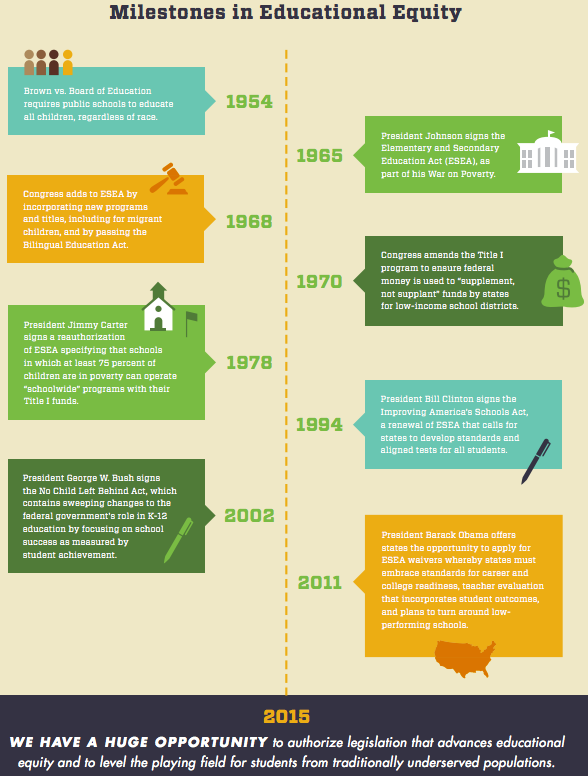
From the Classroom to Congress
ESEA Policy at Play
October 2015

As teachers who have taught under No Child Left Behind (NCLB) – the well-intentioned but flawed reauthorization of the Elementary and Secondary Education Act (ESEA) – we have seen this law fail to reflect the realities of the classroom and the need of our students.

Now we have the chance to make sure that doesn’t happen again–by promoting thoughtful, teacher-created ideas to our Senate and House Congressional members on behalf of the diverse population of students federal law must serve. Our classroom experiences drive us to seek not only school accountability for traditionally underserved students, but also the resources and opportunities to ensure all students are reaching their full potential.
Recommendations:
-
Prevent the dilution Title I dollars for high-poverty schools by keeping the Maintenance of Effort provision, increasing Title I funding and denying the portability of Title I funds.
-
Strengthen school accountability for traditionally underserved students by maintaining required statewide assessments for all students in grade 3-8 and once in grades 10-12, with flexibility for states to intervene in schools failing to serve student subgroups.
- Use Title II funds to promote teacher leadership through hybrid teaching positions and incentivize an equitable distribution of effective teachers by rewarding high-performing teachers to teach in hard-to-staff subjects or schools.

About the Teacher Action Team
We are a team of 11 educators from across the nation who worked together over the course of several weeks to review research on ESEA, federal funding, and teacher career pathways. We drew on E4E’s past policy papers, as well as our own experience in the classroom, to find themes related to ESEA and prioritized them in crafting our recommendations.
Anthony Hernandez 3rd-grade Teacher at Global Academy in Columbia Heights, Minnesota
Rich Johnson 5th-grade Special Education Teacher at PS 105 in New York, New York
Misti Kemmer 4th-grade Teacher at Russell Elementary School in Los Angeles, California
Maya Kruger 5th-grade Teacher at College Prep Elementary School in St Paul, Minnesota
Ben Mackenzie 9th- and 12th-grade English/Language Arts Teacher at FAIR School in Minneapolis, Minnesota
Lynn Osborne Simmons Special Education Teacher at Marie Sklodowska Curie Metropolitan High School in Chicago, Illinois
Christine O’Neil 8th-grade Science Teacher at Blackham School in Bridgeport, Connecticut
Freeda Pirillis 1st-grade Teacher at Agassiz Elementary in Chicago, Illinois
Stephanie Plachy 6th-grade English Language Arts Teacher at Evergreen Middle School for Urban Exploration, New York, New York
Lexie Woo 4th-grade Special Education Teacher at The Dorothy Bonawit Kole School in New York, New York
Michelle Youngblood Jarman 8th-grade Literature Teacher at Eagle Rock Junior/Senior High School in Los Angeles, California